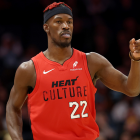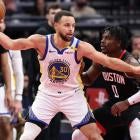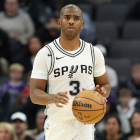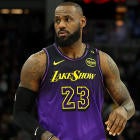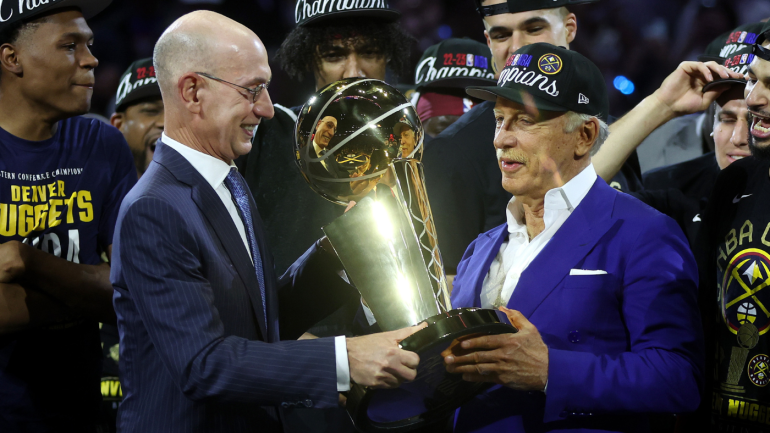
The Denver Nuggets have owned the Los Angeles Lakers since the beginning of 2023. In that time, they have played eight regular-season games and the Nuggets have won all eight of them. They've played nine playoff games and the Nuggets have also won eight of those. Yet when discussing the second of those series, a first-round victory this spring, Kentavious Caldwell-Pope made a somewhat startling admission on The Draymond Green Show. "We felt the Lakers should have beat us," the now-former Nugget said.
The series went only five games, but the Lakers led all five games at halftime. Two of them were decided by a single possession and none by more than 11 points. The most one-sided rivalry in basketball turned into a coin flip because, according to Caldwell-Pope, the Nuggets were simply exhausted. "You know how like, towards the playoffs, guys get their rest?" Caldwell-Pope asked. "But I feel like that's where we spent most of our energy and our time trying to get first place." By the time that Lakers series arrived, the Nuggets were spent. They lost one round later in an upset against the Minnesota Timberwolves. They blew a 20-point Game 7 lead in that series.
We see some version of this story play out pretty much every year. There were 15 series played in the 2024 postseason, and 10 of them included at least one All-Star still in his prime missing at least one game. In 2023, it was seven out of 15. None of this accounts for players who enter the postseason hobbled, like Joel Embiid and Karl-Anthony Towns did this season. It also ignores teams playing through entire series with half of their role players out, as the Knicks did against Indiana this spring or the Timberwolves did against the Nuggets in 2023. The modern NBA playoffs feel far less like a test of skill than a war of attrition. It has become increasingly common for fans to wonder if the best team really won.
There are a number of viable explanations for why this is happening. NBA athletes are more explosive than ever, and perhaps that makes them more injury-prone. ESPN's Baxter Holmes has done some very interesting reporting about the dangers of pushing young players too far at the AAU level. It's also worth noting that injuries aren't exactly a new phenomenon, and they aren't exclusive to basketball either. But Caldwell-Pope spelled out the dilemma many teams and veterans face during the season. They can either prioritize rest or they can prioritize winning. In a perfect world, those shouldn't be things that anyone needs to decide between, so the simplest solution would be building more mandated rest into the schedule. The logical way to do that would be to shorten the schedule.
Adam Silver has pushed back on this concept in the past. "Last season, entirely because of COVID issues which compressed the schedule, we played 72 games," Silver said in 2022, referring to the shortened 2020-21 season. "I thought that was a pretty good answer for all those people who said we'd reduce injuries by playing 10 fewer games, that was quickly forgotten." But this is only a partial truth. The NBA did play fewer games, but it also played them in a much smaller window. The season opened up Dec. 22 and ended on May 16, meaning teams needed to fit 72 games into 146 days. That's one game every 2.03 days. For comparison, the 2023-24 season opened on Oct. 24 and ended on April 14. That's 174 days to fit in 82 games, or one game every 2.12 days. They may have played fewer games during the COVID-shortened season, but they were playing more often. So much for extra rest.
It's also worth acknowledging the league's incentives here. Silver is employed by the NBA's 30 owners. Those owners are running a business. More games mean more revenue. That's just as true for the players as it is for the teams. Players and owners split basketball-related income nearly evenly, with neither side allowed to take in less than 49% or more than 51% of it in a given year. Shortening the schedule would cost everyone money, at least in the short term.
But that is what makes the new national television deal that the NBA agreed to with Disney, NBC and Amazon such a tantalizing opportunity for the league. The league's old nine-year, $24 billion deal generated roughly $2.67 billion in revenue per year. The new 11-year, $76 billion deal would earn around $6.9 billion annually, if the reported numbers are accurate. The NBA is about to receive an enormous influx of cash. Both sides are well within their rights to simply pocket that cash and call it a day, but this infusion represents a real opportunity for the NBA to invest in its future by rethinking core elements of its business. If there was ever a time in which the NBA could afford to take the short-term losses that would come with shortening the schedule, it would be now.
Does the NBA need to rethink its core business practices? Well... no, at least not right now. Professional basketball is an extremely lucrative business. Team valuations have skyrocketed in the past decade or two. This new television deal is an enormous win for the NBA at a time in which media rights deals aren't the automatic home run they once were. The PAC-12 died largely because it couldn't secure an acceptable television deal. Puck's John Ourand has reported that it is "likely" that ESPN will exercise its right to end its deal with Major League Baseball. That's a far cry from TNT fighting tooth and nail to keep its NBA rights even after the league has announced a deal without it. The NBA is a healthy business today. It will almost certainly be a healthy business for a long time moving forward.
But that doesn't make it infallible. The war-of-attrition-style playoffs haven't exactly been a hit with television viewers. Sports Business Journal reported that TV ratings for the playoffs were down 12% last year compared to 2023. At Michael Jordan's peak, the Finals could draw 30 million or more viewers for a game. The relatively one-sided bout between the Celtics and Mavericks this season drew an average of 11.3 million. The regular season has seen dips as well.
There's important context here. Practically everything on television is getting less viewership today than it has in the past. That's part of what made the NBA such a valuable television property during these negotiations. The NBA, and sports as a whole, haven't declined at nearly the same rate that everything else has. The streaming wars have also created more buyers than available sports. That put a premium sport like the NBA in a strong bargaining position. The league maximized that leverage for a great deal. It's way too early to predict exactly what the media landscape looks like 11 years from now, but given the struggles that many streamers have endured, it's reasonable to speculate that the league's leverage might not be quite as strong. On a fundamental level, the NBA's business relies on people watching games, and people are watching less games now than they used to.
The theoretical benefit to shortening the schedule on this front, aside from having healthier players, is that reducing inventory increases the stakes of the remaining games. This conceit is part of what has made football the dominant television property in modern sports. There's no load management in the NFL because nobody can afford it. One loss on a 17-game schedule means much more than it does on an 82-game schedule. It also asks far less of fans. It's much easier to carve out three hours once a week than it is to do so 82 times over the course of six months. Cutting out games makes it easier for fans to find the time to watch the ones that remain. Games meaning more gives fans another incentive to do so.
This matters from a television perspective, but it matters just as much to fans who buy tickets. Imagine a fan can afford to take his family to one game per year. Say that fan's young son's favorite player is LeBron James, so they shell out the premium to see the Lakers the one time all year they come into town. But it's the second night of a back-to-back, so the fan and his family find out 90 minutes before tip that James isn't playing. Obviously, this is the sort of experience that is going to make fans hesitate to buy tickets months in advance, but it's also the sort of experience that makes it harder for the NBA to create lifelong relationships with younger fans. Many basketball fans can trace their fandom back to seeing their favorite player live for the first time. For me, it was Allen Iverson.
Those younger fans become lifelong customers. Hooking them is harder now than it's ever been. A 2021 study showed that only 23% of Gen-Z respondents considered themselves sports fans compared to 42% of millennials. Many of the younger people who do consider themselves fans don't consume the sport in the same way that older ones do. Though quantifying this group would be nearly impossible, there are quite a few fans of the NBA who consume the league primarily through highlights and social media commentary. The NBA is happy to have these fans, obviously, and they can be monetized in other ways, but the league would probably prefer if they were watching the ads their media partners run during games and paying for the tickets that fund their stadiums.
So the NBA is in a healthy financial place today. It probably will be tomorrow. But retaining and developing domestic popularity is getting harder than ever, especially for so-called inventory sports like basketball and baseball. There's no set formula for success under these conditions, but improving the product as much as possible would probably be a good place to start. So I'm going to propose an alternative to the league's current 82-game format that attempts to strike a balance between short-term revenue and long-term strength of the product. This proposal depends on the league's eventual expansion from 30 to 32 teams, which is widely believed to be coming in the next few years:
- Each team plays a home-and-home against every other team in the NBA, regardless of conference affiliation. This takes us to 62 total games.
- The NBA would realign its divisions so that each conference contains four divisions with four teams each. Teams that share a division would play each other four times in total, with two games at each team's home stadium. The idea here would be to help foster geographic rivalries while minimizing travel. This takes us to 68 total games.
- The In-Season Tournament (now the NBA Cup) would be reformatted as a single-elimination tournament. However, there would be loser's brackets after every round. For example, after the first round, there would be 16 winners and 16 losers. The 16 winners would obviously just advance. The 16 losers would then start a new bracket to play for 17th place. This would continue after each round until all 32 teams have placed somewhere between first and 32nd in the tournament, playing five games total regardless of where they finish. In-Season Tournament finish would then become the only tiebreaker used for playoff standings and draft position (in order to incentivize winning from bad teams). The player prize pool would also vary in each slot, with winners getting by far the most and the No. 32 finisher getting the least, which would hopefully ensure that players took even the lower-level games seriously. In total, that takes us to 73 games.
This format would allow the NBA to mostly remove back-to-backs, as every team played between 13 and 15 of them last season. Perhaps by slightly expanding the season's length on the calendar, the league could get rid of them entirely. It would ensure that every team plays in every arena at least once, create a built-in structure to develop rivalries, structure the In-Season Tournament in a slightly more traditional way and, most importantly, hopefully give players and teams enough rest to go into the postseason at full strength.
Now, sadly, we need to throw a little bit of cold water on this plan. The league probably isn't shortening the schedule any time soon. Nobody is going to want to sacrifice the short-term revenue needed to institute a plan like this. Owners might be able to justify it amongst themselves by saying a better product will lead to long-term gains, but remember, the player's union can't think that way. Most players only play a few years. It does them little good to sacrifice salary if they are retired before long-term league growth makes them whole down the line. Perhaps they could be swayed by the physical benefits of playing less. Who wouldn't want nine extra days off, right? More likely, they'd ask for financial concessions that the league wouldn't want to make.
To fans, the NBA is a sport. To the stakeholders, it's a business. Financial interests are almost always going to outweigh fan interests even if fan interest is what drives most of the league's financial interests. Fans would probably rather see the Nuggets enter the playoffs rested and ready to defend their championship than get nine extra games in January and February, and fans getting what they want probably would be the path to a healthy financial future for the NBA, but the league likely doesn't want to deal with "probably" when the cash it would cost to see this vision through is real to them here and now. The new TV deal is perhaps a once-in-a-generation opportunity for the NBA to address many of its greatest flaws, but for the time being, it's probably unrealistic to expect the league to act on it.










